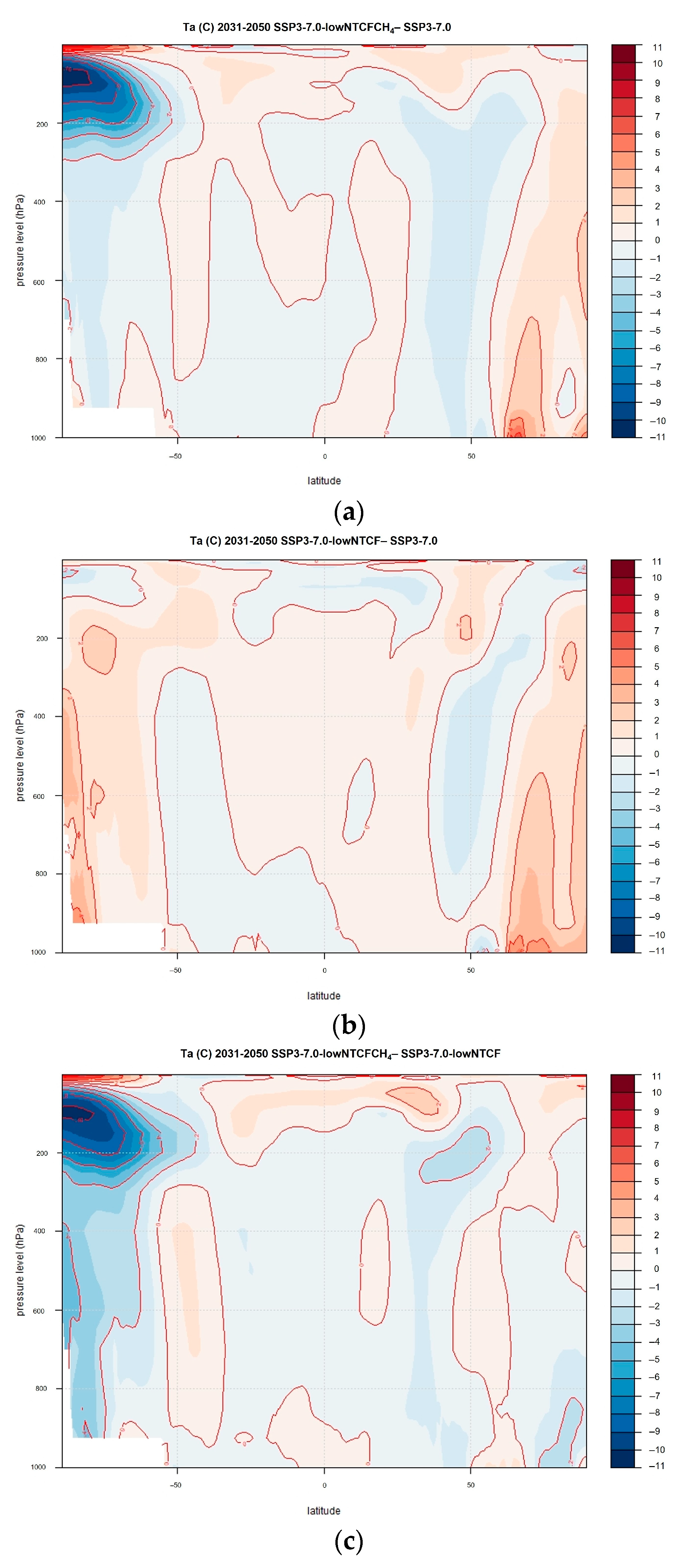Climate Benefits from Methane Mitigation †
Abstract
:1. Introduction
2. Methods
3. Results
4. Conclusions
Author Contributions
Funding
Institutional Review Board Statement
Informed Consent Statement
Data Availability Statement
Acknowledgments
Conflicts of Interest
References
- Allen, R.J.; Horowitz, L.W.; Naik, V.; Oshima, N.; O’Connor, F.M.; Turnock, S.; Shim, S.; Le Sager, P.; van Noije, T.; Tsigaridis, K.; et al. Significant climate benefits from near-term climate forcer mitigation in spite of aerosol reductions. Environ. Res. Lett. 2021, 16, 034010. [Google Scholar] [CrossRef]
- Arias, P.; Bellouin, N.; Coppola, E.; Jones, R.; Krinner, G.; Marotzke, J.; Naik, V.; Palmer, M.; Plattner, G.-K.; Rogelj, J.; et al. Short-Lived Climate Forcers. In Climate Change 2021: The Physical Science Basis. Contribution of Working Group I to the Sixth Assessment Report of the Intergovernmental Panel on Climate Change; Masson-Delmotte, V., Zhai, P., Pirani, A., Connors, S.L., Péan, C., Berger, S., Caud, N., Chen, Y., Goldfarb, L., Gomis, M.I., et al., Eds.; Cambridge University Press: Cambridge, UK; New York, NY, USA, 2021; pp. 817–922. [Google Scholar] [CrossRef]
- EPA. Understanding Global Warming Potentials. Available online: https://www.epa.gov/ghgemissions/understanding-global-warming-potentials (accessed on 11 May 2023).
- EPA. Importance of Methane. Available online: https://www.epa.gov/gmi/importance-methane (accessed on 11 May 2023).
- Dunne, J.P.; Horowitz, L.W.; Adcroft, A.J.; Ginoux, P.; Held, I.M.; John, J.G.; Krasting, J.P.; Malyshev, S.; Naik, V.; Paulot, F.; et al. The GFDL Earth SystemModel Version 4.1 (GFDL-ESM 4.1): Overall coupled model description and simulation characteristics. J. Adv. Model. Earth Syst. 2020, 12, e2019MS002015. [Google Scholar] [CrossRef]
- Collins, W.J.; Lamarque, J.-F.; Schulz, M.; Boucher, O.; Eyring, V.; Hegglin, M.I.; Maycock, A.; Myhre, G.; Prather, M.; Shindell, D.; et al. AerChemMIP: Quantifying the effects of chemistry and aerosols in CMIP6. Geosci. Model Dev. 2017, 10, 585–607. [Google Scholar] [CrossRef]
- O’Neill, B.C.; Kriegler, E.; Riahi, K.; Ebi, K.L.; Hallegatte, S.; Carter, T.R.; Mathur, R.; Van Vuuren, D.P. A new scenario framework for climate change research: The concept of shared socioeconomic pathways. Clim. Chang. 2014, 122, 387–400. [Google Scholar] [CrossRef]
- O’Neill, B.C.; Tebaldi, C.; van Vuuren, D.P.; Eyring, V.; Friedlingstein, P.; Hurtt, G.; Knutti, R.; Kriegler, E.; Lamarque, J.-F.; Lowe, J.; et al. The Scenario Model Intercomparison Project (ScenarioMIP) for CMIP6. Geosci. Model Dev. 2016, 9, 3461–3482. [Google Scholar] [CrossRef]


Disclaimer/Publisher’s Note: The statements, opinions and data contained in all publications are solely those of the individual author(s) and contributor(s) and not of MDPI and/or the editor(s). MDPI and/or the editor(s) disclaim responsibility for any injury to people or property resulting from any ideas, methods, instructions or products referred to in the content. |
© 2023 by the authors. Licensee MDPI, Basel, Switzerland. This article is an open access article distributed under the terms and conditions of the Creative Commons Attribution (CC BY) license (https://creativecommons.org/licenses/by/4.0/).
Share and Cite
Paschou, S.E.; Kalisoras, A.; Zanis, P. Climate Benefits from Methane Mitigation. Environ. Sci. Proc. 2023, 26, 113. https://doi.org/10.3390/environsciproc2023026113
Paschou SE, Kalisoras A, Zanis P. Climate Benefits from Methane Mitigation. Environmental Sciences Proceedings. 2023; 26(1):113. https://doi.org/10.3390/environsciproc2023026113
Chicago/Turabian StylePaschou, Sofia Eirini, Alkiviadis Kalisoras, and Prodromos Zanis. 2023. "Climate Benefits from Methane Mitigation" Environmental Sciences Proceedings 26, no. 1: 113. https://doi.org/10.3390/environsciproc2023026113
APA StylePaschou, S. E., Kalisoras, A., & Zanis, P. (2023). Climate Benefits from Methane Mitigation. Environmental Sciences Proceedings, 26(1), 113. https://doi.org/10.3390/environsciproc2023026113






